頂層視窗管理
Compose Multiplatform for desktop 提供了多種用於管理視窗的功能。您可以將視窗隱藏到系統匣中、使其可拖曳、調整大小、變更位置等等。
開啟和關閉視窗
您可以使用 Window() 函式建立一個常規視窗。若要將其置於可組合的作用域中,請在 application 進入點中使用 Window():
import androidx.compose.ui.window.Window
import androidx.compose.ui.window.application
fun main() = application {
Window(onCloseRequest = ::exitApplication) {
// 視窗內容
}
}作為一個可組合函式,Window() 允許您以宣告式的方式變更其屬性。例如,您可以開啟一個具有特定標題的視窗,然後再變更該標題:
import androidx.compose.material.Button
import androidx.compose.material.Text
import androidx.compose.runtime.getValue
import androidx.compose.runtime.mutableStateOf
import androidx.compose.runtime.remember
import androidx.compose.runtime.setValue
import androidx.compose.ui.window.Window
import androidx.compose.ui.window.application
fun main() = application {
var fileName by remember { mutableStateOf("Untitled") }
Window(onCloseRequest = ::exitApplication, title = "$fileName - Editor") {
Button(onClick = { fileName = "note.txt" }) {
Text("Save")
}
}
}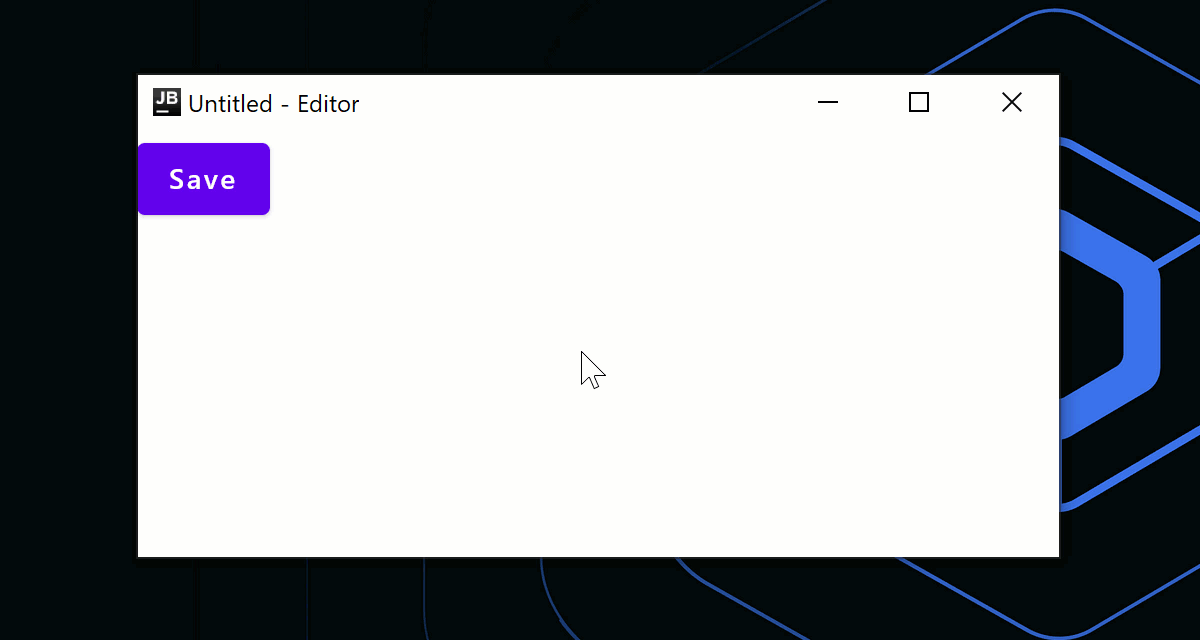
加入條件
您還可以使用簡單的 if 條件來開啟和關閉視窗。在以下程式碼範例中,應用程式視窗在完成任務後會自動關閉:
import androidx.compose.material.Text
import androidx.compose.runtime.LaunchedEffect
import androidx.compose.runtime.getValue
import androidx.compose.runtime.mutableStateOf
import androidx.compose.runtime.remember
import androidx.compose.runtime.setValue
import androidx.compose.ui.window.Window
import androidx.compose.ui.window.application
import kotlinx.coroutines.delay
fun main() = application {
var isPerformingTask by remember { mutableStateOf(true) }
LaunchedEffect(Unit) {
// 執行一些繁重的工作
delay(2000)
isPerformingTask = false
}
if (isPerformingTask) {
Window(
onCloseRequest = ::exitApplication,
title = "Window 1"
)
{
Text("Performing some tasks. Please wait!")
}
} else {
Window(
onCloseRequest = ::exitApplication,
title = "Window 2"
) {
Text("Hello, World!")
}
}
}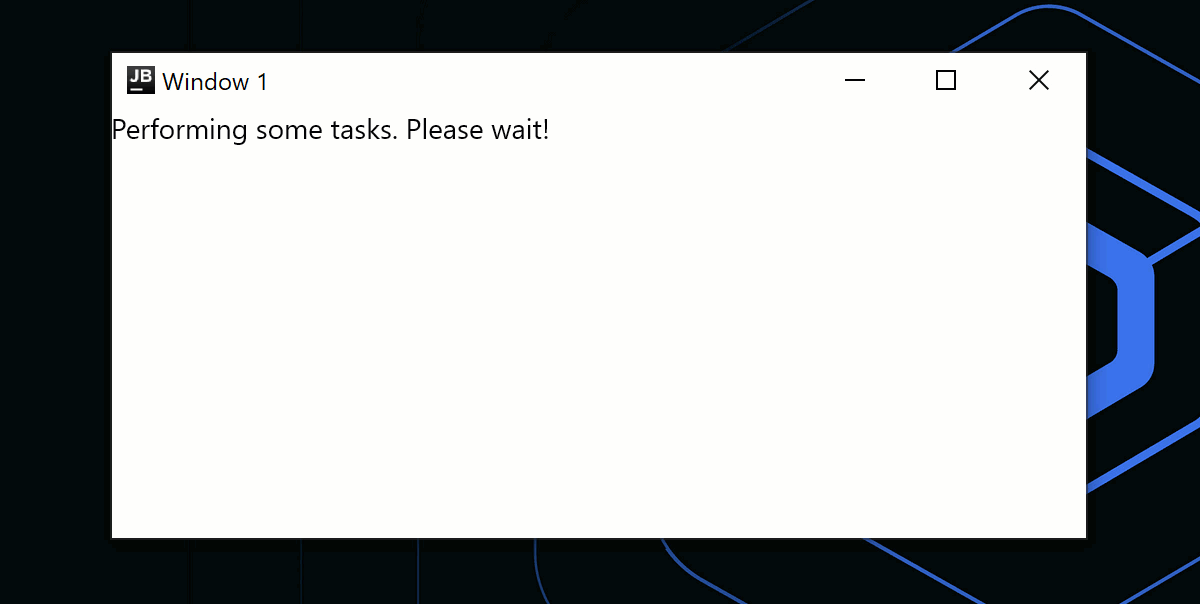
如果您想在應用程式退出時使用自訂邏輯,例如顯示對話方塊,您可以透過 onCloseRequest 回呼來覆寫關閉動作。 在以下程式碼範例中,我們使用宣告式方法來關閉視窗以回應狀態變更 (isOpen = false),而不是使用命令式方法 (window.close())。
import androidx.compose.material.Button
import androidx.compose.material.Text
import androidx.compose.runtime.getValue
import androidx.compose.runtime.mutableStateOf
import androidx.compose.runtime.remember
import androidx.compose.runtime.setValue
import androidx.compose.ui.window.DialogWindow
import androidx.compose.ui.window.Window
import androidx.compose.ui.window.application
fun main() = application {
var isOpen by remember { mutableStateOf(true) }
var isAskingToClose by remember { mutableStateOf(false) }
if (isOpen) {
Window(
onCloseRequest = { isAskingToClose = true },
title = "Important document"
) {
if (isAskingToClose) {
DialogWindow(
onCloseRequest = { isAskingToClose = false },
title = "Close without saving?"
) {
Button(
onClick = { isOpen = false }
) {
Text("Yes")
}
}
}
}
}
}"}
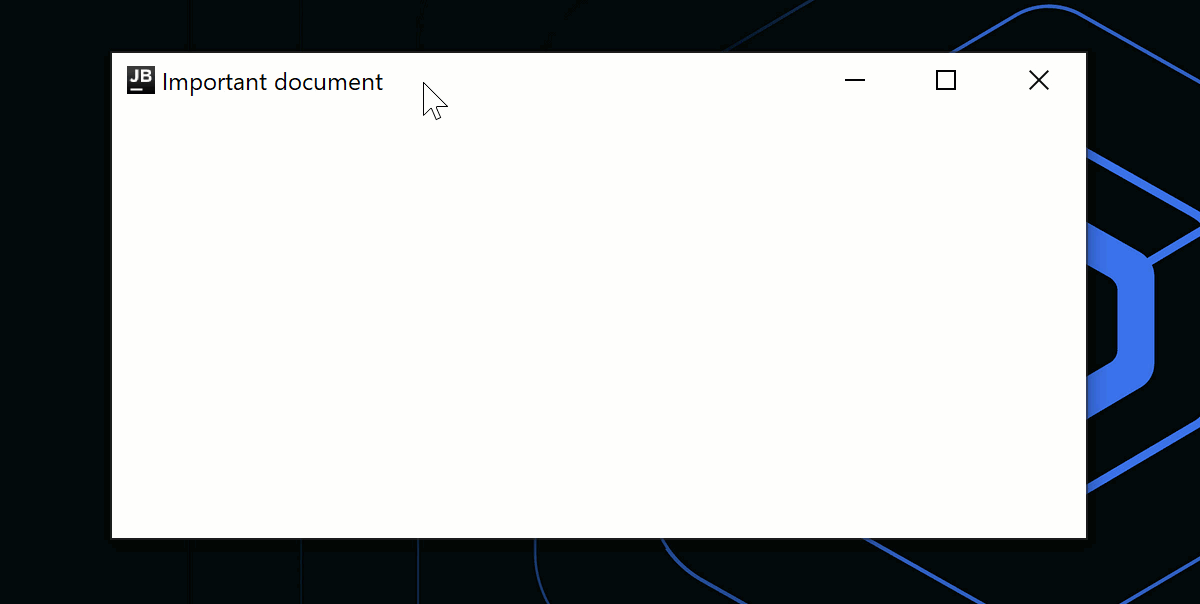
使用多個視窗
如果應用程式有多個視窗,您可以為應用程式狀態建立一個單獨的類別,並根據 mutableStateListOf 的變更來開啟或關閉視窗:
import androidx.compose.runtime.Composable
import androidx.compose.runtime.key
import androidx.compose.runtime.mutableStateListOf
import androidx.compose.runtime.remember
import androidx.compose.ui.window.MenuBar
import androidx.compose.ui.window.Window
import androidx.compose.ui.window.application
fun main() = application {
val applicationState = remember { MyApplicationState() }
for (window in applicationState.windows) {
key(window) {
MyWindow(window)
}
}
}
@Composable
private fun MyWindow(
state: MyWindowState
) = Window(onCloseRequest = state::close, title = state.title) {
MenuBar {
Menu("File") {
Item("New window", onClick = state.openNewWindow)
Item("Exit", onClick = state.exit)
}
}
}
private class MyApplicationState {
val windows = mutableStateListOf<MyWindowState>()
init {
windows += MyWindowState("Initial window")
}
fun openNewWindow() {
windows += MyWindowState("Window ${windows.size}")
}
fun exit() {
windows.clear()
}
private fun MyWindowState(
title: String
) = MyWindowState(
title,
openNewWindow = ::openNewWindow,
exit = ::exit,
windows::remove
)
}
private class MyWindowState(
val title: String,
val openNewWindow: () -> Unit,
val exit: () -> Unit,
private val close: (MyWindowState) -> Unit
) {
fun close() = close(this)
}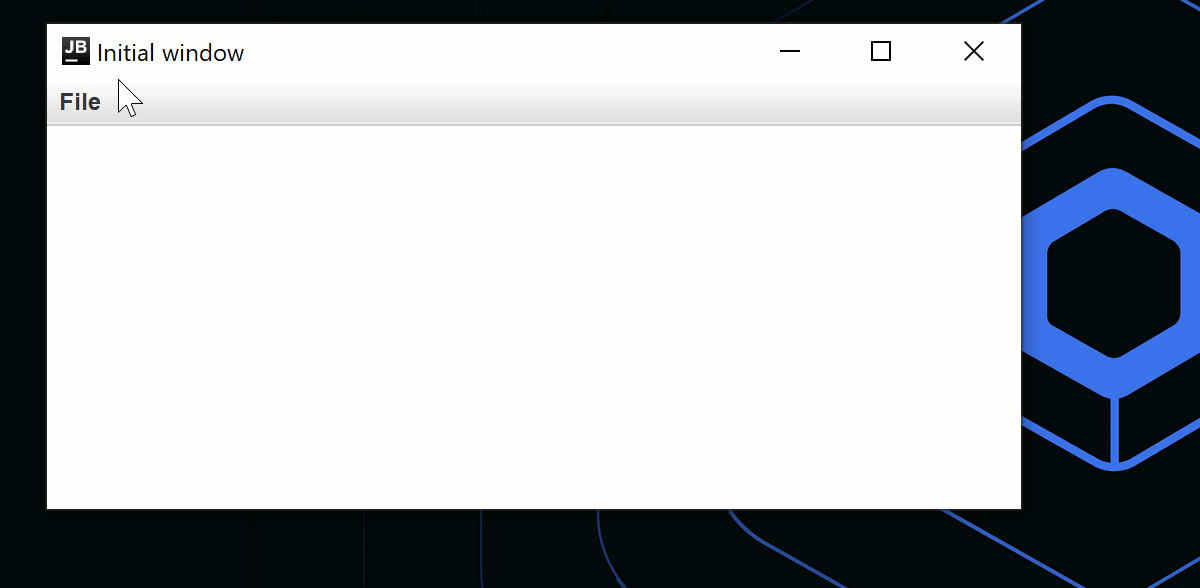
有關更複雜的範例,請參閱 Code Viewer 範例。
將視窗最小化到系統匣
若要隱藏視窗而不是關閉它,您可以變更 windowState.isVisible 狀態:
import androidx.compose.material.Text
import androidx.compose.runtime.LaunchedEffect
import androidx.compose.runtime.getValue
import androidx.compose.runtime.mutableStateOf
import androidx.compose.runtime.remember
import androidx.compose.runtime.setValue
import androidx.compose.ui.geometry.Size
import androidx.compose.ui.graphics.Color
import androidx.compose.ui.graphics.drawscope.DrawScope
import androidx.compose.ui.graphics.painter.Painter
import androidx.compose.ui.window.Tray
import androidx.compose.ui.window.Window
import androidx.compose.ui.window.application
import kotlinx.coroutines.delay
fun main() = application {
var isVisible by remember { mutableStateOf(true) }
Window(
onCloseRequest = { isVisible = false },
visible = isVisible,
title = "Counter",
) {
var counter by remember { mutableStateOf(0) }
LaunchedEffect(Unit) {
while (true) {
counter++
delay(1000)
}
}
Text(counter.toString())
}
if (!isVisible) {
Tray(
TrayIcon,
tooltip = "Counter",
onAction = { isVisible = true },
menu = {
Item("Exit", onClick = ::exitApplication)
},
)
}
}
object TrayIcon : Painter() {
override val intrinsicSize = Size(256f, 256f)
override fun DrawScope.onDraw() {
drawOval(Color(0xFFFFA500))
}
},"}
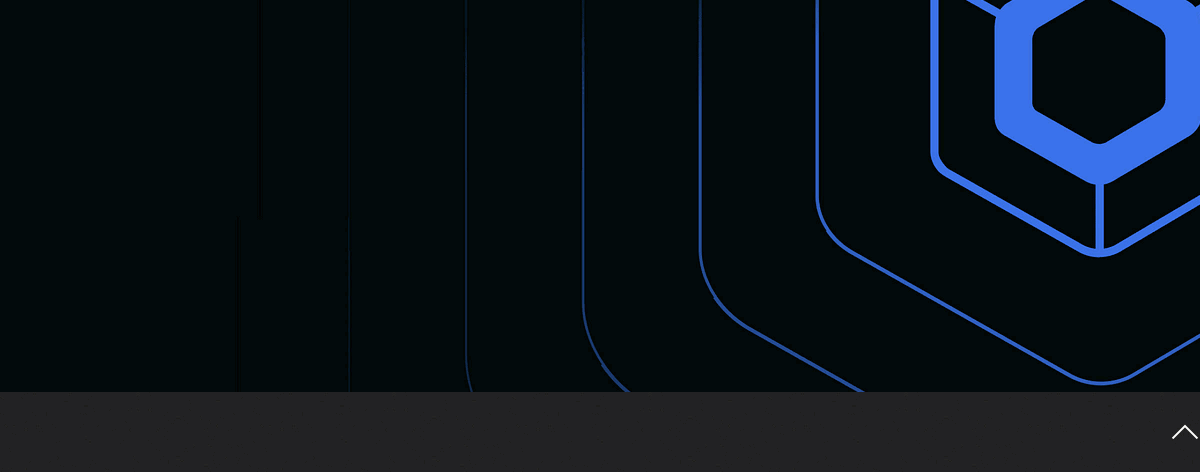
singleWindowApplication() 函式
您可以透過呼叫 singleWindowApplication() 函式來建立單一視窗應用程式。
singleWindowApplication() 函式使用起來更簡單,但有以下限制:
- 應用程式只能有一個視窗。
- 您無法新增自訂關閉邏輯。
- 您無法在執行時變更視窗的屬性。
import androidx.compose.ui.window.singleWindowApplication
fun main() = singleWindowApplication {
// 視窗內容
}作為替代方案,您可以在 application 進入點中使用 Window() 可組合項。
視窗自適應大小
當您不知道預期內容的大小,也無法預先指定最佳視窗尺寸時, 您可以將 WindowSize 的一個或兩個維度設定為 Dp.Unspecified。Compose Multiplatform for desktop 會自動調整視窗的初始大小以適應內容:
import androidx.compose.foundation.background
import androidx.compose.foundation.layout.Column
import androidx.compose.foundation.layout.Row
import androidx.compose.foundation.layout.padding
import androidx.compose.foundation.layout.size
import androidx.compose.material.Text
import androidx.compose.ui.Modifier
import androidx.compose.ui.graphics.Color
import androidx.compose.ui.unit.Dp
import androidx.compose.ui.unit.dp
import androidx.compose.ui.window.Window
import androidx.compose.ui.window.application
import androidx.compose.ui.window.rememberWindowState
fun main() = application {
Window(
onCloseRequest = ::exitApplication,
state = rememberWindowState(width = Dp.Unspecified, height = Dp.Unspecified),
title = "Adaptive size",
resizable = false
) {
Column(Modifier.background(Color(0xFFEEEEEE))) {
Row {
Text("label 1", Modifier.size(100.dp, 100.dp).padding(10.dp).background(Color.White))
Text("label 2", Modifier.size(150.dp, 200.dp).padding(5.dp).background(Color.White))
Text("label 3", Modifier.size(200.dp, 300.dp).padding(25.dp).background(Color.White))
}
}
}
}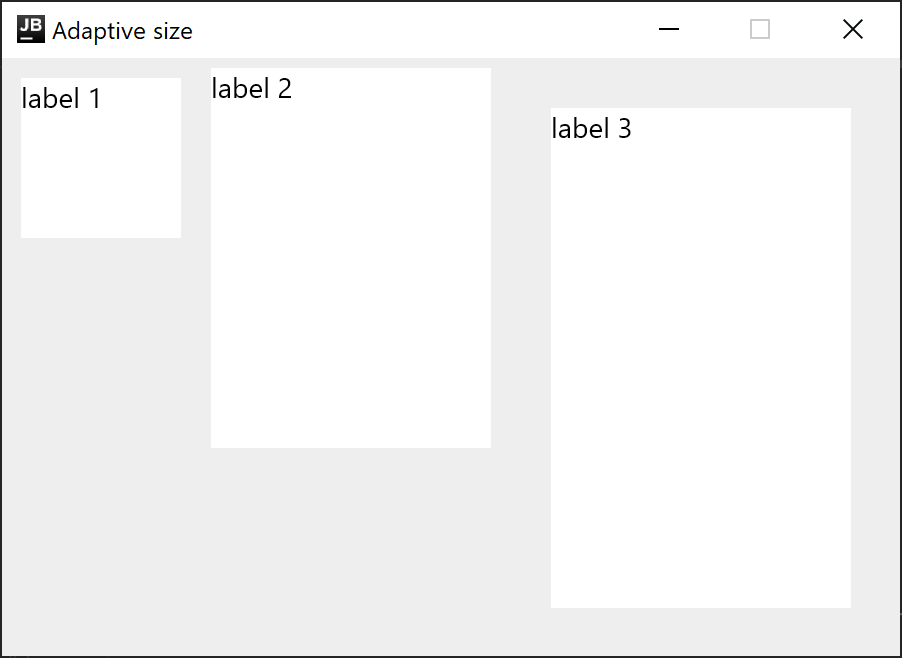
變更視窗狀態
WindowState 是一個獨立的 API 類別,用於視窗的放置方式、目前位置和大小。放置方式屬性允許您指定視窗在螢幕上的放置方式:浮動、最大化/最小化或全螢幕。 任何狀態變更都會觸發自動重新組合。若要變更視窗狀態,請使用回呼或在可組合項中觀察它:
import androidx.compose.foundation.clickable
import androidx.compose.foundation.layout.Column
import androidx.compose.foundation.layout.Row
import androidx.compose.material.Checkbox
import androidx.compose.material.Text
import androidx.compose.ui.Alignment
import androidx.compose.ui.Modifier
import androidx.compose.ui.unit.dp
import androidx.compose.ui.window.Window
import androidx.compose.ui.window.WindowPlacement
import androidx.compose.ui.window.WindowPosition
import androidx.compose.ui.window.application
import androidx.compose.ui.window.rememberWindowState
fun main() = application {
val state = rememberWindowState(placement = WindowPlacement.Maximized)
Window(onCloseRequest = ::exitApplication, state, title = "Window state") {
Column {
Row(verticalAlignment = Alignment.CenterVertically) {
Checkbox(
state.placement == WindowPlacement.Fullscreen,
{
state.placement = if (it) {
WindowPlacement.Fullscreen
} else {
WindowPlacement.Floating
}
}
)
Text("isFullscreen")
}
Row(verticalAlignment = Alignment.CenterVertically) {
Checkbox(
state.placement == WindowPlacement.Maximized,
{
state.placement = if (it) {
WindowPlacement.Maximized
} else {
WindowPlacement.Floating
}
}
)
Text("isMaximized")
}
Row(verticalAlignment = Alignment.CenterVertically) {
Checkbox(state.isMinimized, { state.isMinimized = !state.isMinimized })
Text("isMinimized")
}
Text(
"Position ${state.position}",
Modifier.clickable {
val position = state.position
if (position is WindowPosition.Absolute) {
state.position = position.copy(x = state.position.x + 10.dp)
}
}
)
Text(
"Size ${state.size}",
Modifier.clickable {
state.size = state.size.copy(width = state.size.width + 10.dp)
}
)
}
}
}
監聽視窗狀態
如果您需要回應狀態變更並將值傳送到另一個非可組合的應用程式層級,例如將其寫入資料庫,您可以使用 snapshotFlow() 函式。 此函式會擷取可組合項狀態的目前值。
import androidx.compose.runtime.LaunchedEffect
import androidx.compose.runtime.snapshotFlow
import androidx.compose.ui.unit.DpSize
import androidx.compose.ui.window.Window
import androidx.compose.ui.window.WindowPosition
import androidx.compose.ui.window.application
import androidx.compose.ui.window.rememberWindowState
import kotlinx.coroutines.flow.filter
import kotlinx.coroutines.flow.launchIn
import kotlinx.coroutines.flow.onEach
fun main() = application {
val state = rememberWindowState()
Window(onCloseRequest = ::exitApplication, state) {
LaunchedEffect(state) {
snapshotFlow { state.size }
.onEach(::onWindowResize)
.launchIn(this)
snapshotFlow { state.position }
.filter { it.isSpecified }
.onEach(::onWindowRelocate)
.launchIn(this)
}
}
}
private fun onWindowResize(size: DpSize) {
println("onWindowResize $size")
}
private fun onWindowRelocate(position: WindowPosition) {
println("onWindowRelocate $position")
}.onEach(::onWindowResize)"}
對話方塊
您可以使用 Window() 可組合項來建立一個常規視窗,並使用 DialogWindow() 可組合項來建立一個模態視窗,該視窗會鎖定其父級直到使用者關閉該模態視窗。
以下程式碼範例示範了如何使用這些可組合項來組合常規視窗和模態視窗:
import androidx.compose.material.Button
import androidx.compose.material.Text
import androidx.compose.runtime.getValue
import androidx.compose.runtime.mutableStateOf
import androidx.compose.runtime.remember
import androidx.compose.runtime.setValue
import androidx.compose.ui.Alignment
import androidx.compose.ui.window.DialogWindow
import androidx.compose.ui.window.Window
import androidx.compose.ui.window.WindowPosition
import androidx.compose.ui.window.application
import androidx.compose.ui.window.rememberDialogState
fun main() = application {
Window(
onCloseRequest = ::exitApplication,
) {
var isDialogOpen by remember { mutableStateOf(false) }
Button(onClick = { isDialogOpen = true }) {
Text(text = "Open dialog")
}
if (isDialogOpen) {
DialogWindow(
onCloseRequest = { isDialogOpen = false },
state = rememberDialogState(position = WindowPosition(Alignment.Center))
) {
// 視窗內容
}
}
}
},"}
可拖曳的視窗區域
若要為無邊框視窗新增自訂的可拖曳標題列,或使整個視窗可拖曳,您可以使用 WindowDraggableArea() 可組合項:
import androidx.compose.foundation.background
import androidx.compose.foundation.layout.Box
import androidx.compose.foundation.layout.fillMaxWidth
import androidx.compose.foundation.layout.height
import androidx.compose.foundation.window.WindowDraggableArea
import androidx.compose.ui.Modifier
import androidx.compose.ui.graphics.Color
import androidx.compose.ui.unit.dp
import androidx.compose.ui.window.Window
import androidx.compose.ui.window.application
fun main() = application {
Window(onCloseRequest = ::exitApplication, undecorated = true) {
WindowDraggableArea {
Box(Modifier.fillMaxWidth().height(48.dp).background(Color.DarkGray))
}
}
}"}
WindowDraggableArea() 只能在 singleWindowApplication()、Window() 和 DialogWindow() 可組合項內部使用。若要在另一個可組合函式中呼叫它,請使用 WindowScope 作為接收器作用域:
import androidx.compose.foundation.background
import androidx.compose.foundation.layout.Box
import androidx.compose.foundation.layout.fillMaxWidth
import androidx.compose.foundation.layout.height
import androidx.compose.foundation.window.WindowDraggableArea
import androidx.compose.runtime.Composable
import androidx.compose.ui.Modifier
import androidx.compose.ui.graphics.Color
import androidx.compose.ui.unit.dp
import androidx.compose.ui.window.Window
import androidx.compose.ui.window.WindowScope
import androidx.compose.ui.window.application
fun main() = application {
Window(onCloseRequest = ::exitApplication, undecorated = true) {
AppWindowTitleBar()
}
}
@Composable
private fun WindowScope.AppWindowTitleBar() = WindowDraggableArea {
Box(Modifier.fillMaxWidth().height(48.dp).background(Color.DarkGray))
}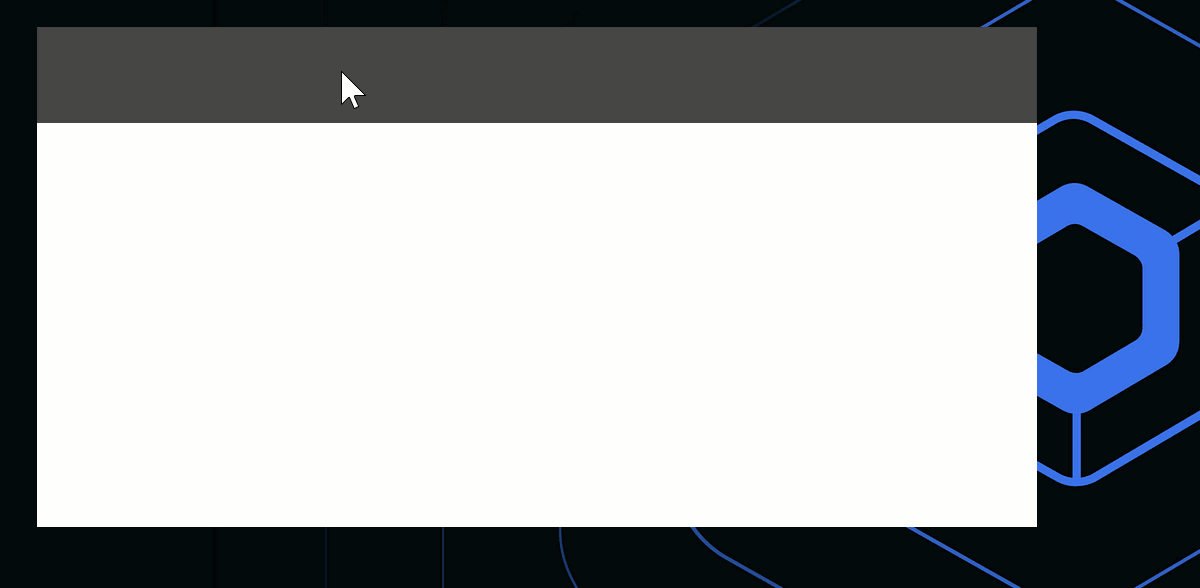
透明視窗及其他自訂
若要建立透明視窗,請將兩個參數傳遞給 Window() 函式:transparent=true 和 undecorated=true。 視窗必須是無邊框的,因為透明視窗不可能有邊框。
以下程式碼範例示範了如何組合可組合項以建立具有圓角的透明視窗:
import androidx.compose.foundation.layout.fillMaxSize
import androidx.compose.foundation.layout.padding
import androidx.compose.foundation.shape.RoundedCornerShape
import androidx.compose.material.Surface
import androidx.compose.runtime.mutableStateOf
import androidx.compose.runtime.remember
import androidx.compose.ui.Modifier
import androidx.compose.ui.draw.shadow
import androidx.compose.ui.graphics.Color
import androidx.compose.ui.unit.dp
import androidx.compose.ui.window.Window
import androidx.compose.ui.window.application
import androidx.compose.material.Text
import androidx.compose.runtime.*
fun main() = application {
var isOpen by remember { mutableStateOf(true) }
if (isOpen) {
Window(
onCloseRequest = { isOpen = false },
title = "Transparent Window Example",
transparent = true,
// 透明視窗必須是無邊框的
undecorated = true,
) {
Surface(
modifier = Modifier.fillMaxSize().padding(5.dp).shadow(3.dp, RoundedCornerShape(20.dp)),
color = Color.Transparent,
// 具有圓角的視窗
shape = RoundedCornerShape(20.dp)
) {
Text("Hello World!", color = Color.White)
}
}
}
}Swing 互通性
Compose Multiplatform for desktop 在底層使用了 Swing,因此您可以直接使用 Swing 建立視窗:
import androidx.compose.ui.awt.ComposeWindow
import java.awt.Dimension
import javax.swing.JFrame
import javax.swing.SwingUtilities
fun main() = SwingUtilities.invokeLater {
ComposeWindow().apply {
size = Dimension(300, 300)
defaultCloseOperation = JFrame.DISPOSE_ON_CLOSE
setContent {
// 視窗內容
}
isVisible = true
}
}您還可以使用 Window() 可組合項的作用域。在以下程式碼範例中,window 是在 Window() 內部建立的 ComposeWindow:
import androidx.compose.runtime.LaunchedEffect
import androidx.compose.ui.window.singleWindowApplication
import java.awt.datatransfer.DataFlavor
import java.awt.dnd.DnDConstants
import java.awt.dnd.DropTarget
import java.awt.dnd.DropTargetAdapter
import java.awt.dnd.DropTargetDropEvent
fun main() = singleWindowApplication {
LaunchedEffect(Unit) {
window.dropTarget = DropTarget().apply {
addDropTargetListener(object : DropTargetAdapter() {
override fun drop(event: DropTargetDropEvent) {
event.acceptDrop(DnDConstants.ACTION_COPY)
val fileName = event.transferable.getTransferData(DataFlavor.javaFileListFlavor)
println(fileName)
}
})
}
}
}如果您需要使用在 Swing 中實作的對話方塊,可以將其包裝到一個可組合函式中:
import androidx.compose.runtime.Composable
import androidx.compose.runtime.getValue
import androidx.compose.runtime.mutableStateOf
import androidx.compose.runtime.remember
import androidx.compose.runtime.setValue
import androidx.compose.ui.window.AwtWindow
import androidx.compose.ui.window.application
import java.awt.FileDialog
import java.awt.Frame
fun main() = application {
var isOpen by remember { mutableStateOf(true) }
if (isOpen) {
FileDialog(
onCloseRequest = {
isOpen = false
println("Result $it")
}
)
}
}
@Composable
private fun FileDialog(
parent: Frame? = null,
onCloseRequest: (result: String?) -> Unit
) = AwtWindow(
create = {
object : FileDialog(parent, "Choose a file", LOAD) {
override fun setVisible(value: Boolean) {
super.setVisible(value)
if (value) {
onCloseRequest(file)
}
}
}
},
dispose = FileDialog::dispose
)下一步
探索有關 其他桌面元件 的教學課程。
